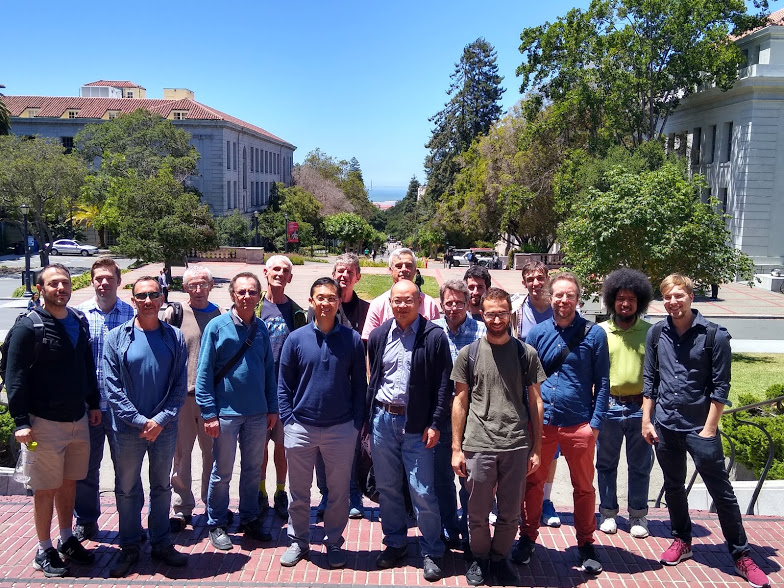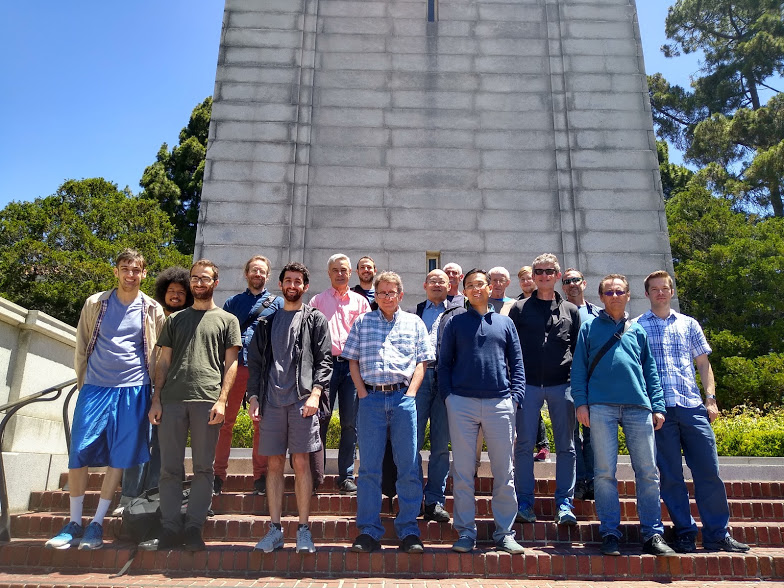 |
© Gregor Schindler 2019
Berkeley conference on
inner model theory
 |
July 08--19, 2019
This conference will be a sequel to the 1st Conference on the core model induction and hod mice that was held in Münster (FRG), July 19 -- August 06, 2010, to the 2nd Conference on the core model induction and hod mice that was held in Münster (FRG), August 08 -- 19, 2011, to the AIM Workshop on Descriptive Inner Model Theory, held in Palo Alto (CA), June 02 -- 06, 2014, to the Conference on Descriptive Inner Model Theory, held in Berkeley (CA) June 09 -- 13, 2014 to the 3rd Münster Conference on inner model theory, the core model induction, and hod mice that was held in Münster (FRG), July 20 -- 31, 2015, to the 1st Irvine conference on descriptive inner model theory and hod mice that was held in Irvine (CA), July 18 -- 29, 2016, to the 4th Münster Conference on inner model theory, the core model induction, and hod mice that was held in Münster (FRG), July 17 -- August 01, 2017, as well as to the 1st Girona conference on inner model theory that was held in Girona (Catalonia), July 16 -- 27, 2018.
Once more, this conference will now draw together researchers and advanced students with an interest in inner model theory, in order to communicate and further explore recent work. There will be courses and single talks.
We will meet Monday--Friday, with 2 1/2 hours of lectures in the morning and 2 1/2 hours of lectures in the afternoon. This will leave ample time for problem sessions, informal seminars, and other interactions.
We gratefully acknowledge financial support through an NSF grant, by the Berkeley Group in Logic and the Methodology of Science, and through a DFG grant (Mathematics Münster: Dynamics - Geometry - Structure).
The talks will take place 748 Evans Hall, and breaks will be in the Alfred Tarski room, 737 Evans Hall.
Schedule:
| Mon, July 08 | Tue, July 09 | Wed, July 10 | Thu, July 11 | Fri, July 12 | |
| 9:30--10:45 | Schindler: part 1 | Schindler: part 3 | Steel: part 1 | Zeman: part 1 | Schimmerling: part 1 |
| 11:15--12:30 | Schindler: part 2 | Schindler: part 4 | Steel: part 2 | Zeman: part 2 | Schimmerling: part 2 |
| 14:30--15:45 | Goldberg | Ben-Neria 1 | Adolf: part 1 | Gitik | Rudominer: part 1 |
| 16:15--17:30 | Jackson | Ben-Neria 2 | Adolf: part 2 | Siskind | Rudominer: part 2 |
| 17:30--∞ | Problems and Discussions | Problems and Discussions | Problems and Discussions | Problems and Discussions | free |
| Mon, July 15 | Tue, July 16 | Wed, July 17 | Thu, July 18 | Fri, July 19 | |
| 9:30--10:45 | Trang: part 1 | Chan: part 1 | Schlutzenberg: part 3 | Shi | --- |
| 11:15--12:30 | Trang: part 2 | Chan: part 2 | Schimmerling: part 3 | Wilson II | --- |
| 14:30--15:45 | Wilson I | Schlutzenberg: part 1 | Trang: part 3 | Fernandes | --- |
| 16:15--17:30 | --- | Schlutzenberg: part 2 | Steel: part 3 | Trang: part 4 | --- |
| 17:30--∞ | Problems and Discussions | Problems and Discussions | Problems and Diskussions | Problem Session | free |
Problem list, talks, and abstracts:
Let A be the set of reals which are Δ1ω +1 in a countable ordinal. A is analoguous to Q3. We will describe a mouse M and show that the set of reals of M is equal to A. This is analoguous to R ∩ M1 = Q3.
M is the least mouse such that for all n ∈ ω there is a δn such that δn is a cardinal of M and is Woodin in M with respect to Σ1n subsets of δn. This mouse was isolated in 1993 and at that time we proved that R ∩ M ⊂ A, but we were not able to prove that A ⊂ M. Recently Woodin proved that A ⊂ M yielding the mouse set theorem.
This talk will focus on Woodin's proof that if a real x is Δ1ω +1 in a countable ordinal, then x is in M.
Theorem 0.1 Assume ADR + HPC; then HOD is a model of GCH.
Here HPC stands for "hod pair capturing," a natural assumption concerning the existence of mouse pairs. An analysis of optimal Suslin representations for mouse pairs leads to
Theorem 0.2 Assume ADR + HPC; then the following are equivalent:
(a) δ is Woodin in HOD, and a cutpoint of the extender sequence of HOD,
(b) δ = θ0 or δ = θα +1 for some α.
Here the θα's are the Solovay sequence. Grigor Sargsyan introduced a refinement of the Solovay sequence in which ordinal definability from sets of reals is replaced by ordinal definablity from countable sequences of ordinals. Calling these ordinals ηα we have
Theorem 0.3 Assume ADR HPC; then the following are equivalent:
(a) δ is a successor Woodin in HOD,
(b) δ = η0 or δ = ηα +1 for some α.
This theorem was conjectured by Sargsyan.
Reference: Mouse pairs and Suslin cardinals by J. Steel.
People who participated:
| Dominik Adolf (Bar Ilan Univ., Ramat Gan) | ✓ | |
| Omer Ben-Neria (Jerusalem) | ||
| David Casey (UC Berkeley) | ✓ | |
| Justin Cavitt (Harvard Univ., Cambridge, MA) | ✓ | |
| William Chan (Denton, TX) | ✓ | |
| Gabriel Fernandes (Bar Ilan Univ., Ramat Gan) | ✓ | |
| Elliot Glazer (Harvard Univ., Cambridge, MA) | ✓ | |
| Gabriel Goldberg (Harvard Univ., Cambridge, MA) | ✓ | |
| Takehiko Gappo (Rutgers Univ.) | ✓ | |
| Moti Gitik (Tel Aviv) | ||
| Steve Jackson (Denton, TX) | ✓ | |
| Andreas Lietz (Münster) | ✓ | |
| Mitch Rudominer (San Francisco) | ||
| Ernest Schimmerling (CMU) | ||
| Ralf Schindler (Münster) | ✓ | |
| Farmer Schlutzenberg (Münster) | ✓ | |
| Xianghui Shi (Beijing) | ✓ | |
| Benjamin Siskind (UC Berkeley) | ✓ | |
| John Steel (UC Berkeley, CA) | ✓ | |
| Nam Trang (UC Irvine) | ✓ | |
| Trevor Wilson (Miami Univ., Oxford OH) | ✓ | |
| Martin Zeman (UC Irvine, CA) | ✓ |
 |
 |
 |